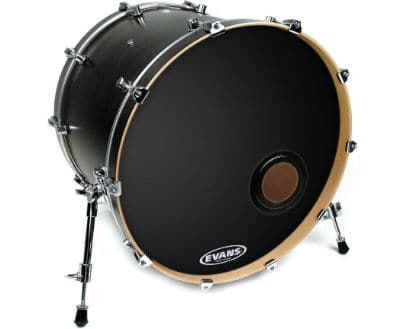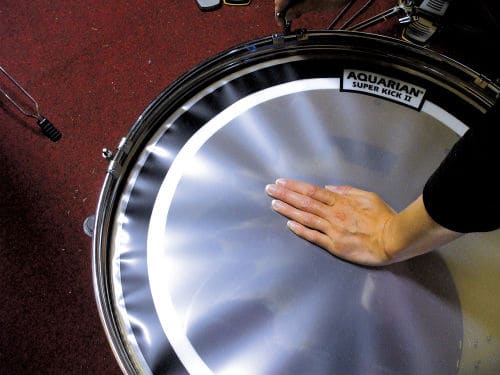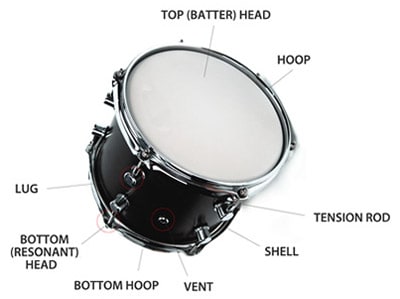Last Updated on May 17, 2021 by Danny
Tuning drums is one of the cheapest ways to improve the sound of your drums. It can make a cheap kit sound great and a great kit sounds magnificent. While it might look like a complicated task, it’s actually not that difficult. A well-tuned bass drum will not only put a thump in your audience’s heart, but will also make your practice sessions more enjoyable. Here are the various aspects you have to consider while tuning your kick drum.
Should My Resonant Head Have A Hole Cut In It?

Having a hole cut is something that can be beneficial, but not at all times. If you do decide to cut a hole in your drum, it should be because you need to, not because the drummer your idolise does it. They are often used to improve the beater attack sound.
However, an intact drum head is actually extremely desirable when you have chosen the correct head and tuned it properly. You should be cautious about cutting a hole in your drum as it will have a significant impact on the sound, so think twice before you get a hole cut into it.
A typical hole in the resonant head is only between three and five inches big. Anything bigger than five inches and your bass drum will sound extremely flat, and anything smaller than 3 inches will not be having any realistic impact on the sound.
The change in sound not only depends on the size of the hole, but also its position and the number of holes. You mostly need only one hole, two holes are rarely beneficial and you usually end up with a flat sounding drum in most cases.
As far as position is considered, if you place a hole right in the centre of the kick drum, you will have too much air rushing out following every stroke, thereby leading to a loss of tone. It is usually better to keep the hole towards the edge of the drum as it allows air particles to bounce a couple more times before leaving the drum.
You could also take cutting a hole on your resonant head up a notch and completely remove the resonant head. This is usually done in studio settings to get the demanded sound for your track. It is completely up to the individual whether they want or don’t want to remove the resonant head, so feel free to experiment. However, keep in mind that removing the resonant head does compromise the structural integrity of the shell.
Picking a Bass Drum Head
Having the right drum head for your music needs will go a long way towards your drumming. There are different types of bass drum heads: Coated or uncoated drum heads, two ply or one ply drum heads, hydraulic drum heads, or drum heads with a power stripe. Most drummers use a singly ply drum head for the resonant head.
Do a little research and obtain the right head for your purpose.
To set the head on your shell, first place the head on it and slowly tighten the tuning rods to finger tight. Make sure that you tighten them in opposite pairs.
Once you have tightened everything, place your hand in the centre and stretch the head. Now check the tuning rods once again to make sure that everything is still finger tight.

If you use a new head, a few rods are bound to get loosened. If you have holes in the front end, lean on the skin while simultaneously pressing in the centre. If the hole is in the dead centre of the drum, you will have to skip this step.
Setting the Heads
You should start by tuning the batter head first, ensure that you remove the resonant head beforehand. Once done with the batter head, install the resonant head and start tuning it.
Batter (Striking) Head

Similar to attaching the drumhead, you must finger tight all your tuning rods until all the wrinkles have been removed. You must increase the tension progressively, that is a little at a time. Tighten each rod a little by little as you go around the drum in rounds.
Under no circumstances should you crank each rod. Make sure that you have your desired level of bounce. Once you are done with this step, just do a simple test to make sure you have a uniform pitch all around the drum.
Resonant (Front) head
The resonant head also starts out similarly. The head must be installed and the tuning rods must be made finger tight. Keep your hand on the center and remove all wrinkles. Ensure that the pitch is uniform across the head.
Start The Tuning Process
We have not done any tuning till now, we have just removed the wrinkles and made sure that the pitch is uniform. Now upright the drum and attach your kick drum pedal to it. Slowly play a steady pulse and start tuning the resonant head towards the sound you want.
As you start tuning it, you will notice the increased pitch and the improved clarity. If you want a punchy and focused sound, you will need to spend quite some time gently playing with the tension until you get the sound you want.
Nicely tightening will give you higher frequencies that are suitable for jazz and similar genres. Low tension will yield nice powerful basal tones that are perfect for genres like rock.
You can get the thumpy sound by tuning the batter head until all wrinkles are gone and loosening it just enough to see a small wrinkle while ensuring that the head is properly stretched. Then nicely tighten the resonant head. This will yield a nice low punchy sound.
Most drummers want their kick drum to pack a powerful low-frequency punch. They achieve this by tuning the drums to the lowest possible levels. While this is ok on a small bass drum, it becomes an issue with bass drums that are 24” or bigger.
When these drums are tuned to their lowest possible point, their fundamental frequency falls lower than what humans can perceive and all you end up hearing is the overtones. So you end up with rather anemic sound than something punchy.

In such cases, you can get a more powerful sound by simply tightening the bass drum. While it might seem against the norm, you will get the results you want.
So, if you have a large drum that sounds week, just tighten it to a slightly higher pitch and you might get the punch you are looking for
Dampening/Muffling of Drum

There are a million different ways to dampen or muffle your bass drum, from stuffing old towels into the kick drum to spending money on branded products. While towels and pillows are good enough when you are just starting out, spending a little money on specific products for dampening can improve your aesthetics and sound.
The dampening effect also varies with the part you decide to dampen. If you muffle just the batter head, you will probably be left with all the overtunes of the resonant head while also losing some of the beater’s attack.
We do not want this under most circumstances.
If you muffle just the resonant head, you will get a nice attack from the beater while the resonant head’s overtones are controlled. This is an excellent setup for rock, metal, and similar genres.
The final option is to dampen both the resonant and batter head, this will have reduced overtunes from the resonant head while having a lesser attack. Plastic beaters sound better in this manner.
Another important thing to consider while muffling is the environment you play in. If you are gigging, you probably do not need heavy dampening. Too much dampening could actually lead to your bass drum being lost among other sounds in a live setting.
However, studio work can really benefit from good dampening. Rock music also tends to require higher levels of dampening compared to jazz, as jazz needs a more open sound. Unless you see a need for it, keep dampening to a minimum.
Conclusion
The tuning of your bass drum really depends on the music you want to play. If you want to play rock, you will have to tune the drum lower and get more basal notes. If you wanna play jazz, you will have to tune the drum tighter and get higher frequencies.
Once you have decided on your genre, you will have to make drum head choices, tuning levels, and muffling all based on that. This article just gives you the fundamentals to get started. Feel free to experiment and have fun tuning.